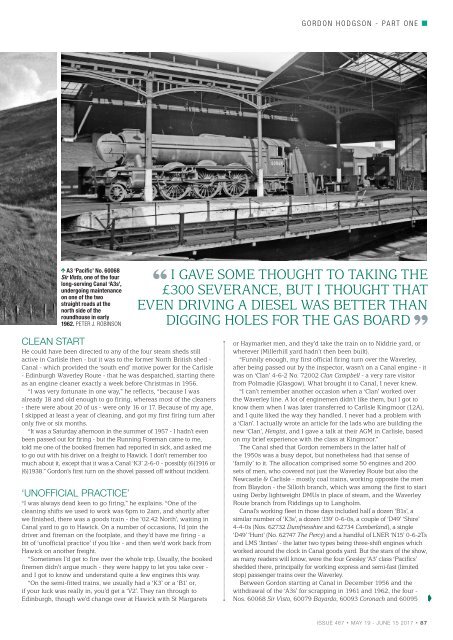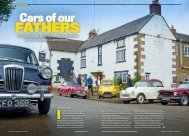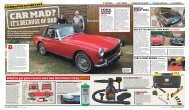Create successful ePaper yourself
Turn your PDF publications into a flip-book with our unique Google optimized e-Paper software.
GORDON HODGSON - PART ONE<br />
A3 ‘Pacific’ No. 60068<br />
Sir Visto, one of the four<br />
long-serving Canal ‘A3s’,<br />
undergoing maintenance<br />
on one of the two<br />
straight roads at the<br />
north side of the<br />
roundhouse in early<br />
1962. PETER J. ROBINSON<br />
I gave some thought to taking the<br />
£300 severance, but I thought that<br />
even driving a diesel was better than<br />
digging holes for the gas board<br />
Clean start<br />
He could have been directed to any of the four steam sheds still<br />
active in Carlisle then - but it was to the former North British shed -<br />
Canal - which provided the ‘south end’ motive power for the Carlisle<br />
- Edinburgh Waverley Route - that he was despatched, starting there<br />
as an engine cleaner exactly a week before Christmas in 1956.<br />
“I was very fortunate in one way,” he reflects, “because I was<br />
already 18 and old enough to go firing, whereas most of the cleaners<br />
- there were about 20 of us - were only 16 or 17. Because of my age,<br />
I skipped at least a year of cleaning, and got my first firing turn after<br />
only five or six months.<br />
“It was a Saturday afternoon in the summer of 1957 - I hadn’t even<br />
been passed out for firing - but the Running Foreman came to me,<br />
told me one of the booked firemen had reported in sick, and asked me<br />
to go out with his driver on a freight to Hawick. I don’t remember too<br />
much about it, except that it was a Canal ‘K3’ 2‐6‐0 - possibly (6)1916 or<br />
(6)1938.” Gordon’s first turn on the shovel passed off without incident.<br />
‘UNOFFICIAL PRACTICE’<br />
“I was always dead keen to go firing,” he explains. “One of the<br />
cleaning shifts we used to work was 6pm to 2am, and shortly after<br />
we finished, there was a goods train - the ‘02.42 North’, waiting in<br />
Canal yard to go to Hawick. On a number of occasions, I’d join the<br />
driver and fireman on the footplate, and they’d have me firing - a<br />
bit of ‘unofficial practice’ if you like - and then we’d work back from<br />
Hawick on another freight.<br />
“Sometimes I’d get to fire over the whole trip. Usually, the booked<br />
firemen didn’t argue much - they were happy to let you take over -<br />
and I got to know and understand quite a few engines this way.<br />
“On the semi-fitted trains, we usually had a ‘K3’ or a ‘B1’ or,<br />
if your luck was really in, you’d get a ‘V2’. They ran through to<br />
Edinburgh, though we’d change over at Hawick with St Margarets<br />
or Haymarket men, and they’d take the train on to Niddrie yard, or<br />
wherever (Millerhill yard hadn’t then been built).<br />
“Funnily enough, my first official firing turn over the Waverley,<br />
after being passed out by the inspector, wasn’t on a Canal engine - it<br />
was on ‘Clan’ 4‐6‐2 No. 72002 Clan Campbell - a very rare visitor<br />
from Polmadie (Glasgow). What brought it to Canal, I never knew.<br />
“I can’t remember another occasion when a ‘Clan’ worked over<br />
the Waverley line. A lot of enginemen didn’t like them, but I got to<br />
know them when I was later transferred to Carlisle Kingmoor (12A),<br />
and I quite liked the way they handled. I never had a problem with<br />
a ‘Clan’. I actually wrote an article for the lads who are building the<br />
new ‘Clan’, Hengist, and I gave a talk at their AGM in Carlisle, based<br />
on my brief experience with the class at Kingmoor.”<br />
The Canal shed that Gordon remembers in the latter half of<br />
the 1950s was a busy depot, but nonetheless had that sense of<br />
‘family’ to it. The allocation comprised some 50 engines and 200<br />
sets of men, who covered not just the Waverley Route but also the<br />
Newcastle & Carlisle - mostly coal trains, working opposite the men<br />
from Blaydon - the Silloth branch, which was among the first to start<br />
using Derby lightweight DMUs in place of steam, and the Waverley<br />
Route branch from Riddings up to Langholm.<br />
Canal’s working fleet in those days included half a dozen ‘B1s’, a<br />
similar number of ‘K3s’, a dozen ‘J39’ 0‐6‐0s, a couple of ‘D49’ ‘Shire’<br />
4‐4‐0s (Nos. 62732 Dumfriesshire and 62734 Cumberland), a single<br />
‘D49’ ‘Hunt’ (No. 62747 The Percy) and a handful of LNER ‘N15’ 0‐6‐2Ts<br />
and LMS ‘Jinties’ - the latter two types being three-shift engines which<br />
worked around the clock in Canal goods yard. But the stars of the show,<br />
as many readers will know, were the four Gresley ‘A3’ class ‘Pacifics’<br />
shedded there, principally for working express and semi-fast (limited<br />
stop) passenger trains over the Waverley.<br />
Between Gordon starting at Canal in December 1956 and the<br />
withdrawal of the ‘A3s’ for scrapping in 1961 and 1962, the four -<br />
Nos. 60068 Sir Visto, 60079 Bayardo, 60093 Coronach and 60095<br />
Issue 467 • MAY 19 - JUNE 15 2017 • 87

















